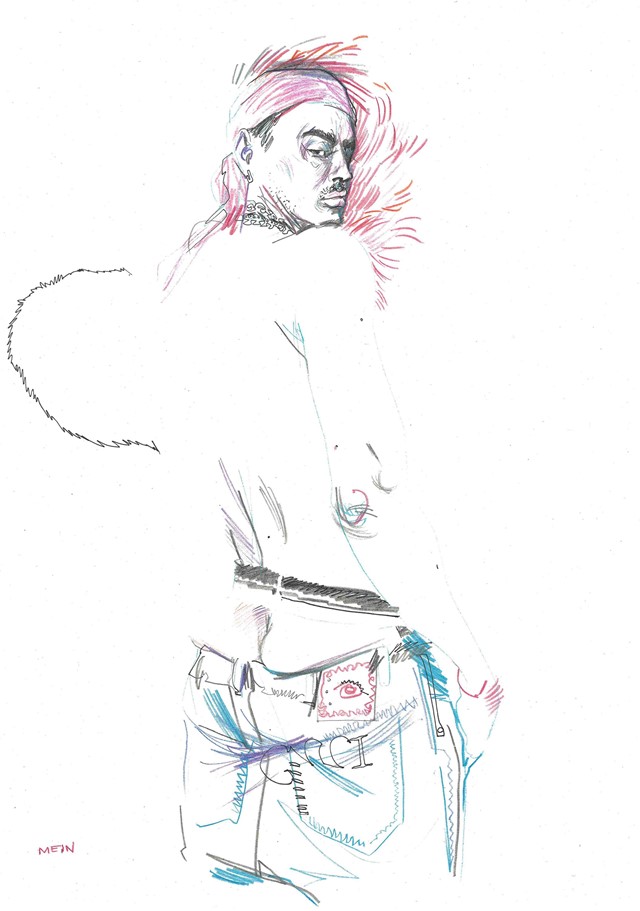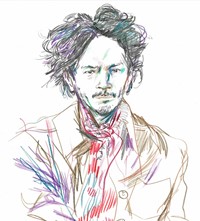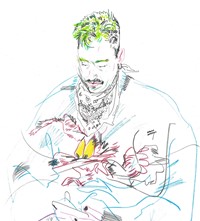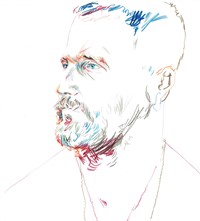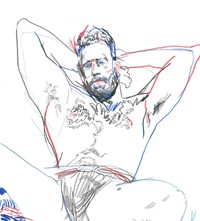The Illustrator Creating Sensual Drawings of the Male Form
- TextHynam Kendall
Meeting Mr Mein: London-based artist Alex Mein sits down with Hynam Kendall and shares three drawings creatively exclusively for Another Man
Name: Alex Mein. Otherwise known as Mr Mein.
Hometown: London, Chiswick.
Now lives: London, Dalston.
Background: “My mum is black Jamaican, my dad white English. She was travelling and found herself here where dad was running a modelling agency which he’d started in the late 60s. I was always drawing as a kid but chose to study fashion design. I studied at Ravensbourne but it turned out I couldn’t make clothes at all. After that I went back into print design and then fashion illustration. There was also a five-year period [when I worked] as a menswear buyer for an independent store called Diverse. Art came back into focus about four years ago after moving into lecturing. I realised I could be utilising my commute time rather than being bored or frustrated by it. I hadn’t drawn properly for ten years at that point – and then the commute changed everything.”
His craft: “I’m self-taught, other than art GCSE and A-Level. There’s no training in what I do, so I understand being described as ‘lo-fi’. To be honest, I don’t have the words to aptly describe my style in academic terms but what I hope it looks like is lines that have fallen – seemingly randomly – onto a piece of paper, and these lines only make sense as a whole once all have fallen. When I started out I think it was fair to have called my art fashion illustration, but now, in both content and style, it seems to have become more like documentary. There is still fashion in what I’m drawing, but I’m detailing and documenting the fashion I see, not selling it.”
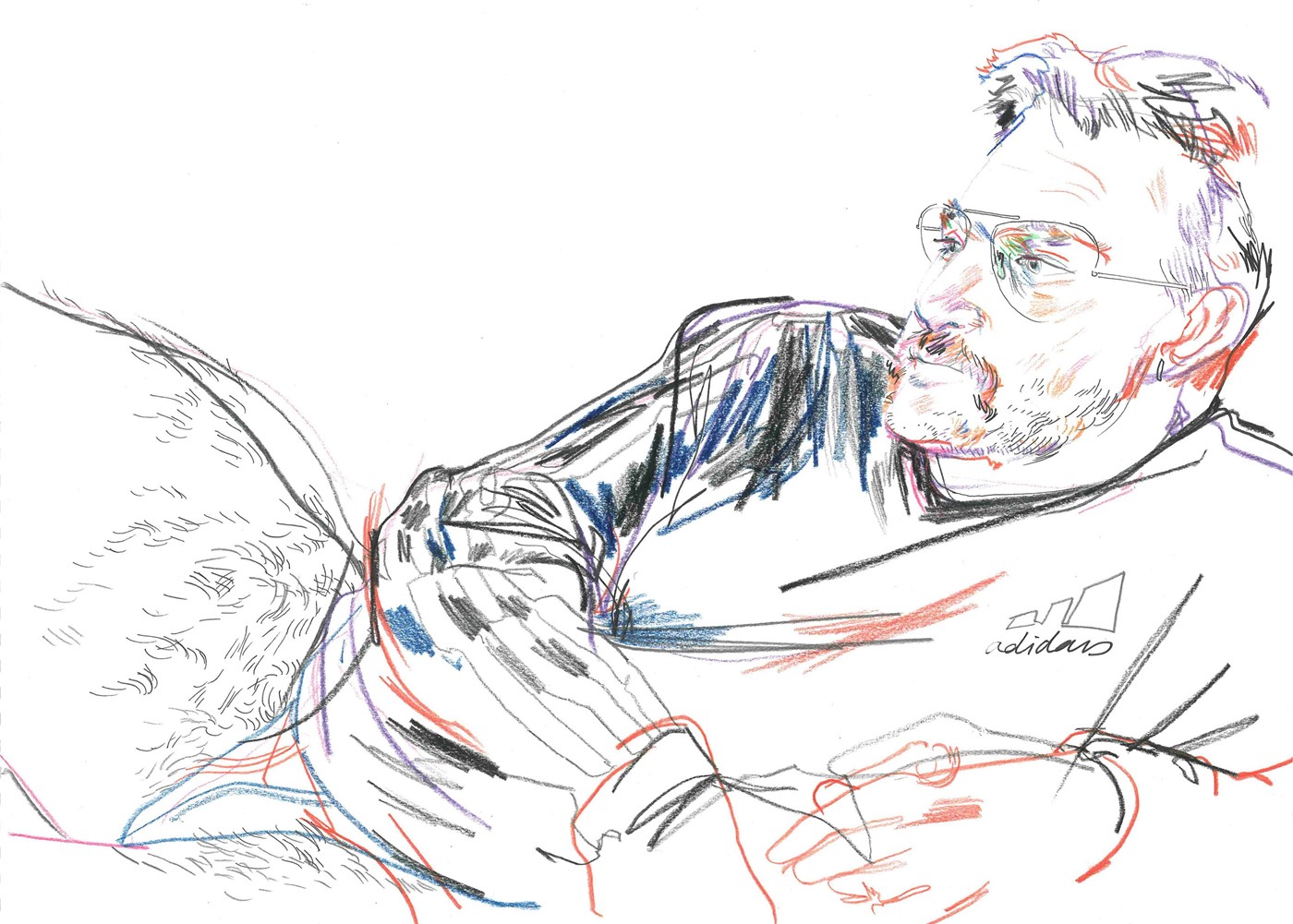
Public transport is his studio: “People move fast. You see that on the train. They come and go at speed. And maybe they see that you’re drawing them – if they do, you never quite know what will happen. I’ve been made to rip up my artwork by the subject before, only once though. Really, it’s mostly an icebreaker. People don’t communicate on London transport but art is a protagonist for conversation. Reactions are interesting. Strange. You know when someone won’t like it but sometimes I dare myself to draw those subjects that you can’t read, when you don’t know what will happen. Will they allow it? A man is drawing them, will they think this OK in a public space? And then the contained environment it’s happening in only adds adrenaline to the situation. But if there are no issues, usually on my commute from Dalston to Highbury I’ve got a person fully done, pending complexity.”
Social media is his gallery space: “The internet is there to utilise if you want it. I can understand why some artists and illustrators reject it, but they can’t deny it. I used to be anxious about the reactions from followers when I uploaded images of the commuter illustrations; I would concern myself over whether it would register with followers. I was anticipating the number of likes I might or might not get. It felt like a tool for validation. But what I’ve learnt over the years from sharing my art on my Mr Mein Instagram account, is that there’s not one correct way to do it. It’s your opportunity to show your art, your way. Realistically, if you want people to see your art, you must use it, so just make it work for you. I see artists with the most incredibly curated social channels – as though it is their own private exhibition. But I just post what I like. I don’t base my uploads on what will secure the most positive feedback. You can like social media or not, but you can’t argue with the fact that it is, essentially, a new kind of gallery.”

His muses last for eight minutes: “I don’t go back to one great muse. There isn’t one. I walk onto the train platform every day ready to see the most exciting person I’ve ever seen. And every day someone comes. And every day they are my muse; physically in front of me and waiting to be found. I am surprised, challenged. Or they are an emblem of something – a time, a place. Whatever it is, when you find it, it can be like the drawing draws itself. The muse isn’t only the person but also that exact moment you share with them. My muses come and go in the eight-minutes of my commute. My muse is many. Is transient. I had one today and I’ll have one tomorrow.”
The gay male gaze: “I don’t illustrate only men, but I find myself drawing them again and again, always returning to the male form. When you grow up gay, as a boy you know you are not supposed to look at men. Every glimpse of a man – especially one that you might find beautiful – is stolen. You aren’t allowed it. You must snatch it and hide it. It is a secret. And if you dared to look, there is a time period for how long you are allowed to. Before they notice. Before they know. And then you must worry – what will be the response to your looking? What will they do if you do look too long? I believe, as a gay man, you’re fundamentally instilled with this way of thinking.
“Now, as an adult, for me there’s a joy in being able to look, a sheer pleasure in looking and being allowed to. And being allowed to find that man beautiful. Or challenging. Or interesting. Whatever it may be. I see with the male gaze, but as a gay artist it is more than that: a gay man has a different kind of seeing. I think I’m looking always for that moment I wasn’t allowed. Trying to capture that vapour. That’s why I think there’s a duality of beauty and hardness in my art – these portraits of men are an act of love.”
Follow Alex Mein on Instagram here.
